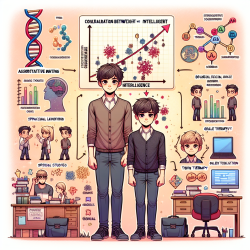Introduction
The intriguing correlation between height and intelligence has long been a subject of scientific inquiry. The research article "On the sources of the height–intelligence correlation: New insights from a bivariate ACE model with assortative mating" by Beauchamp et al. (2010) provides a comprehensive analysis of this phenomenon using an extended bivariate ACE model. This blog aims to distill the key findings of the study and explore how practitioners, particularly those involved in special education and online therapy services, can leverage these insights to enhance their practice.
Understanding the Height-Intelligence Correlation
The study highlights a robust positive correlation between height and intelligence, often measured through IQ tests. The researchers utilized a bivariate ACE model that incorporates assortative mating—a concept where individuals with similar traits are more likely to pair. This model helps decompose the genetic correlation into components attributable to assortative mating and pleiotropy (where one gene influences multiple traits).
Key Findings
- Genetic and Environmental Factors: The study found that both genetic and environmental factors contribute to the height-intelligence correlation. Specifically, 31% of the correlation is due to genetic factors, while 59% is attributed to common environmental factors.
- Assortative Mating: The research underscores the significance of assortative mating in understanding the genetic correlation between height and intelligence. The model's sensitivity to assumptions about assortative mating suggests that neglecting this factor could lead to biased estimates.
- Within-Family Correlation: The study also reports a significant within-family correlation between height and intelligence, suggesting that pleiotropy might play a role in this association.
Implications for Practitioners
For practitioners in special education and online therapy, these findings offer several avenues for application and further research:
- Holistic Assessment: When assessing students, consider both genetic and environmental factors that may influence cognitive abilities. This holistic approach can lead to more tailored and effective educational strategies.
- Research and Development: Encourage further research into the genetic and environmental determinants of cognitive abilities. This could involve collaborations with geneticists and psychologists to develop more comprehensive intervention programs.
- Awareness of Assortative Mating: Understanding the role of assortative mating can enhance the interpretation of genetic data and its implications for educational outcomes.
Conclusion
The study by Beauchamp et al. (2010) provides valuable insights into the complex interplay between height and intelligence. By incorporating these findings into practice, educators and therapists can improve their understanding of cognitive development and devise more effective interventions. As we continue to unravel the genetic and environmental influences on intelligence, the potential for enhancing educational outcomes through informed practice becomes increasingly promising.
To read the original research paper, please follow this link: On the sources of the height–intelligence correlation: New insights from a bivariate ACE model with assortative mating.










